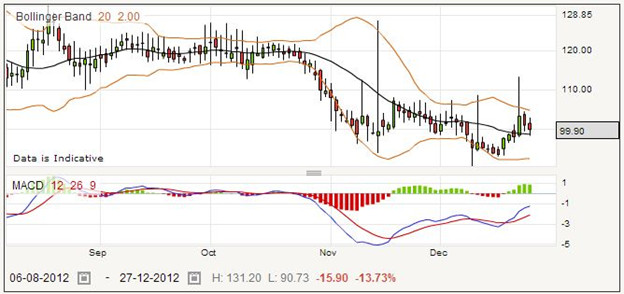Colt Telecom Group (COLT), also known simply as the Colt Group, is an international telecommunications and data services company, with headquarters in London. Its performance over the last few years has been less than sparkling, and you can see a great deal of volatility which would be of interest for spread betting in the daily price chart below. Although Colt is headquartered in London, it is registered in Luxembourg.

It provides telephone and data services to all sizes of business in 21 countries across Europe. It was founded in 1992 as City Of London Telecommunications (COLT) using finance from Fidelity Investments. The following year it was granted a license to compete with British Telecom and Cable and Wireless to provide voice and data services.
The company was placed on the London Stock Exchange in 1996. It expanded into the European market. Fidelity Investments added further capital in 2001 to facilitate expansion, and eventually in 2005 the company achieved its first year of positive cash flow, followed by its first year of profit in 2007.
Buoyed on by this success, it sought more funding from the markets in 2009 by issuing some more shares, and rebranded itself to the name of Colt, rather than the acronym COLT. The group now has three business units, Colt Enterprise Services, Colt Communication Services, and Colt Data Centre Services.
As indicated at the start, the pan-European telecoms services supplier has not been a great success so far. The company is trying to enter the data revenues market as its traditional voice income falls. But this is not proving easy by any standard, data revenues having only rose marginally compared to its legacy
broadband decline rate. At the beginning of 2011, the shares peaked at just over 160, and since then they have been down to 75, up again to 130, and now have dropped to around the hundred level. You can also see from the chart above that there have been some outlying trades, with the wicks and the candlesticks indicating that prices have swung far outside the open and closing prices.
Colt Telecom Group Rolling Daily: How to Spread Bet on Colt Telecom Group Shares?
With the volatility that you see in the daily price chart, you need to be careful to time your entries and exits for maximum benefit. The current quotation for a rolling daily bet is 98.55 – 99.05. Say you decide that the price is going down, you could place a short or sell bet at 98.55, staking perhaps £40 per point. Your choice of stake depends on your account size, but in this case is fairly high because of the low overall value of the shares.
If your short position is a winner, you might close your bet to collect your profits when the quote is 89.85 – 90.35. Your bet opened at a price of 98.55, and it closed at the price of 90.35. That means you have gained 98.55 minus 90.35 points, which is 8.2 points. With a stake of £40 per point, your profit is £328.
Some of the time your bets will not win, and you must accept that and move on to the next bet. Say the price went up to 102.90 – 103.40, and you chose to cut your losses and end the trade. Your closing price this time would be 103.40, so taking away the opening price of 98.55 you would have lost 4.85 points. For the wager of £40 per point, that amounts to £194.
An alternative way to close a losing trade much favoured by some spread betters is the stop loss order, which will reliably close your bet whether or not you are online or checking prices. With a stop loss order, this short bet might have closed when the quote was 101.16 – 101.66. The closing price would be 101.66, which is 3.11 points more than the opening price. Multiplying 3.11 times £40 gives you the amount of £124.40, which you would have lost on this trade.
Colt Telecom Group Futures Style Bet
When you take out a futures style bet, you are usually looking a few weeks or months away before you expect to take your profit. Even so, a futures bet can be closed as simply and quickly as a daily bet at any time, which you might want to do if the price suddenly takes a turn for the worst. The current quote for a far quarter futures bet on Colt is 98.91 – 100.11. Say you take out a long position, staking £25 per point.
As an example, assume the price goes up to 111.96 – 113.16 and you close your bet. You opened your bet at a price of 100.11. You closed it at a price of 111.96. That means you gained 111.96 minus 100.11 points, which works out to 11.85 points. If you multiply this by £25, your stake, you will find that you have won £296.25.
But what if the price goes down? Perhaps the price would slip to 94.56 – 95.76 before you decide to cut your losses and close the trade. Your starting price as before was 100.11, but this time your closing price is 94.56. That means you have lost 100.11 minus 94.56 points. This is 5.55 points, which for a wager of £25 per point means a loss of £138.75.
Many spread traders decide to use a stop loss order, which is usually placed when you take out your original bet. It requires your spread betting provider to close your trade if it goes down to a losing level that you set. With a stop loss order, this bet might have closed at a price of 96.30 – 97.50, saving you some money. 100.11 minus 96.30 is 3.81 points. As you staked £25 per point, your loss is 3.81 times £25, which is £95.25.